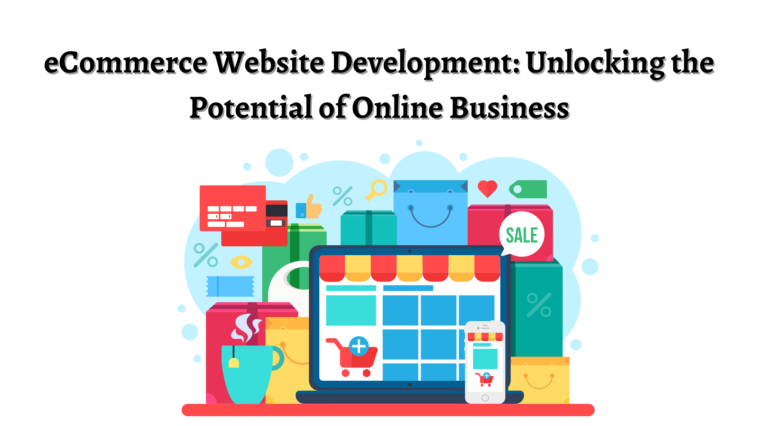Welcome to the realm of developing eCommerce websites, where business expansion meets digital transformation. For businesses of all sizes, having a strong online presence is essential in today’s fast-paced and connected world. An eCommerce website can help you reach a larger audience, boost sales, and improve the visibility of your brand, regardless of how big or little your business is.
In this thorough guide, we’ll examine every aspect of developing an e-commerce website, from its significance and advantages to the critical procedures needed to create a productive online store. So let’s get started and realize the potential of developing an eCommerce website!
Why eCommerce Website Development Matters
-
The Shift to Online Shopping
The retail scene has drastically changed in recent years as customers increasingly gravitate to Internet shopping for its convenience, variety, and affordable prices. This trend was further encouraged by the COVID-19 epidemic as consumers sought out safer alternatives to in-person shopping. As a result, eCommerce sales have increased dramatically, necessitating the creation of a strong online presence for companies.
-
Increased Reach and Global Expansion
The ability to contact customers outside of specific geographic areas is one of the main benefits of developing an eCommerce website. In contrast to conventional brick-and-mortar stores, an online store enables you to access a global market and serve clients from all over the world. Your sales potential can be greatly increased by this increased reach, and it can also create new growth prospects.
-
24/7 Availability and Convenience
An eCommerce website is available 24/7, allowing users to browse and buy things at their convenience, in contrast to conventional stores with set operating hours. Modern consumers, who frequently choose the adaptability of internet purchasing, have a variety of wants and lifestyles that are catered to by this round-the-clock availability. You may give your customers an unmatched level of comfort by embracing eCommerce website development.
-
Cost-Effectiveness and Scalability
The development of an eCommerce website is more affordable than opening a conventional retail location. As there is no requirement to rent or maintain a physical place, the initial investment and overhead expenses are much lower. An online store also offers scalability, which enables you to extend your product selection and meet rising client demand without incurring significant additional costs.
Also Read: What is Mern Stack
The Essential Steps in eCommerce Website Development
Step 1: Planning and Research
Any successful eCommerce website development project starts with meticulous planning and in-depth research. Begin by defining your goals, target audience, and unique selling proposition. Conduct market research to understand your competition, industry trends, and customer preferences. This information will serve as a solid foundation for designing and building your online store.
Step 2: Choose the Right Platform
For your online business to be successful, it is essential to choose the correct eCommerce platform. Options are available in many different forms, each with unique attributes and capabilities. Shopify, WooCommerce, Magento, and BigCommerce are a few popular e-commerce platforms. When making your choice, take into account elements like usability, customization possibilities, scalability, and integration potential.
Step 3: Design and User Experience
A visually appealing and user-friendly design is crucial for engaging visitors and driving conversions. Pay attention to the layout, color scheme, and typography to create a professional and cohesive brand image. Ensure that your website is optimized for mobile devices, as a significant portion of online traffic comes from smartphones and tablets. Provide a seamless user experience by simplifying navigation, incorporating intuitive search functionality, and optimizing page load speeds.
Step 4: Product Catalog and Inventory Management
Building a comprehensive product catalog is at the core of eCommerce website development. Clearly categorize and display your products, including high-quality images, detailed descriptions, and pricing information. Implement an inventory management system to track stock levels, automatically update availability, and trigger alerts for reordering. Streamlining the catalog and inventory management process is crucial for efficient operations and customer satisfaction.
Step 5: Secure Payment Gateway and Checkout Process
A secure and seamless payment process is essential for building trust and encouraging customers to complete their purchases. Integrate a reliable payment gateway that supports multiple payment options and ensures the security of sensitive customer information. Optimize the checkout process by minimizing the number of steps, offering guest checkout, and providing clear instructions at each stage.
Step 6: Search Engine Optimization (SEO)
Implementing effective SEO strategies is vital for driving organic traffic to your eCommerce website. Conduct keyword research to identify relevant terms and incorporate them naturally into your product descriptions, blog posts, and meta tags. Optimize your website’s structure, headings, and URLs for better search engine visibility. Additionally, focus on link building, social media integration, and content marketing to improve your search rankings and attract more potential customers.
Conclusion
The emergence of eCommerce websites is a game-changer for companies hoping to succeed in the digital era. You may open up new business prospects, connect with a global audience, and give your clients unrivaled convenience by embracing the potential of online selling. Recall to methodically plan, select the appropriate platform, give user experience top priority, optimize for search engines, and implement strong security measures. In the cutthroat online marketplace, you may take your company to new heights with the appropriate strategy and a well-done eCommerce website.
To expand your eCommerce business globally, you need a well-thought-out eCommerce Business Guide. It’s a strategic move that can open up new growth opportunities. To succeed, consider tailoring your marketing strategies to local preferences, adapting your product offerings to diverse markets, and addressing logistical challenges. By understanding the unique dynamics of each international market, you can build a strong global presence and increase your eCommerce business’s reach and profitability.
FAQs
- What are the benefits of eCommerce website development?
eCommerce website development offers numerous benefits, including increased reach and global expansion, 24/7 availability and convenience, cost-effectiveness and scalability, and the ability to target and personalize marketing efforts.
- How long does it take to develop an eCommerce website?
The timeline for eCommerce website development can vary depending on the complexity of the project, customization requirements, and the availability of resources. On average, it may take several weeks to a few months to develop a fully functional online store.
- Can I integrate my eCommerce website with social media platforms?
Yes, integrating your eCommerce website with social media platforms is highly recommended. It allows you to leverage the power of social media marketing, engage with your audience, and drive traffic to your online store.
- What security measures should I implement for my eCommerce website?
To ensure the security of your eCommerce website and protect sensitive customer data, you should implement SSL encryption, use a secure payment gateway, regularly update your software and plugins, and conduct routine security audits.
- How can I optimize my eCommerce website for mobile devices?
To optimize your eCommerce website for mobile devices, you should utilize responsive web design principles, prioritize mobile-friendly navigation and user interface, optimize page load speeds, and ensure that all content and features are easily accessible on smaller screens.
- How can I promote my eCommerce website and drive traffic?
To promote your eCommerce website and drive traffic, you can utilize various digital marketing strategies such as search engine optimization (SEO), social media marketing, email marketing, influencer collaborations, content marketing, and paid advertising campaigns.




Comments
0 comments